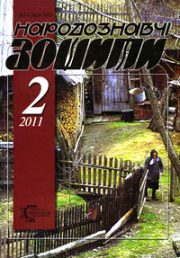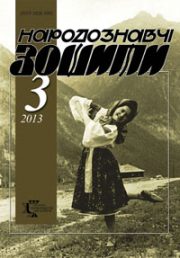The Ethnology Notebooks. 2023. № 5 (173), 1247—1255
UDK 339.16.012.32:636.2(477.83)
DOI https://doi.org/10.15407/nz2023.05.1247
«IF THE DEVIL TAKES THE ROPE, HE WILL TAKE THE COW»: LOCAL TRADITIONS OF CATTLE TRADING
POZHODZHUK Dmytro
- ORCID ID: https://orcid.org/0000-0003-1207-9388
- Doctor of Philosophy, assistant,
- Department of History of Ukraine and Economic Theory,
- 50, Pekarska St., 79010, Lviv, Ukraine,
- Contacts: e-mail: pozhodzhuk@lvet.edu.ua
Abstract. Customs and rituals of cattle trade are still poorly studied to this day, since they have been dealt. At the same time, the offered topic resonates with many other areas of traditional Ukrainian ritual culture.
Relevance of this research also lies in the fact that it is based on thematic field materials from historical and ethnographic Volyn collected by the author in person.
The article purpose is to describe trade-related cattle customs and rituals discovered in villages Dubrivka, Zakrynychchia, Kozhushky, Krasulia, Myroslavl, Serednia, and Ternivka in Zviahel district of Zhytomyr region.
The research object is customary practices associated with purchase and sale of livestock (including cattle).
The survey subject is: the custom of giving money «for good luck»; the custom of «rake-offs» in the context of buying and selling livestock; rituals with a tether or sack; magical practices performed with the purchased cattle in a new household; the issue of choosing the color; ritual methods of buying cattle used if the cattle «did not settle».
Chronological limits of the research cover the second half of the 19th and early 21st centuries, and the territorial boundaries are settlements of historical and ethnographic Volyn. At the same time, the author has attracted much broader comparative material.
Accordingly, the research methodology is based on descriptive and comparative-historical methods, and previously on an ethnographic component that consisted in an oral interview of respondents using a pre-designed thematic questionnaire.
Keywords: ethnology, cattle breeding, historical and ethnographic Volyn, Zviahel district, buying and selling cattle, money «for good luck», tether, color.
Received 1.08.2023
REFERENCES
- Zubryts’kyj, M. (1905). Feeding, buying and selling sheep in Mshantsy of the Old Sambir County. Materiialy do ukrains’ko-rus’koi etnol’ogii (Vol. VI, pp. 1—40) [in Ukrainian].
- Krasykov, M. (2010). Ukrainian Folk Customs Relating to Buying of a Cow: Moderm Magical Practice. Folk Art and Ethnography, 6, 62—67 [in Ukrainian].
- Pozhodzhuk, D. (2018). Livestock Trade of the Volynians: Customs and Beliefs. Folk Art and Ethnology, 2, 88—95 [in Ukrainian].
- (2019). Archive of Ivan Franko National University of Lviv. F. R-119. Op. 17. Reference 700-E [in Ukrainian].
- Hlushko, M. (2018). Historical and Ethnographic Zoning of Ukraine: A Modern State and Scientific Prospects. Folk Art and Ethnology, 3, 9—20 [in Ukrainian].
- Hlushko, M. (Ed.). (2012). Wedding in Dubrivtsi village of Baraniv district, Zhytomyr region. Visnyk of the Lviv University. Series History, 47, 268—343 [in Ukrainian].
- Hlushko, M. (1985). Harvesting ritual of Dubrivka residents. Folk art and ethnography, 5, 69 [in Ukrainian].
- Hlushko, M. (2015). Traditional Medicine of Volhynia (Based on the Records Gathered in the Village of Dubrivka, Baranivka District, Zhytomyr Region). Visnyk of the Lviv University. Series History, 51, 549—580 [in Ukrainian].
- Hlushko, M. (2009). The Kupaylo [Feast of John the Baptist’s Birth] Songs of Eastern Volhynia from the Village of Dubrivka, Baranivka raion, Zhytomyr oblast. Mythology and Folklore, 1, 75—84 [in Ukrainian].
- (2017). An Ethnographic Image of Modern Ukraine: A Corpus of Expeditionary Materials of Folklore and Ethnographic Studies. Vol. 1—10 (Vol. 7: Economic Occupations, Handicrafts, and Trades) [in Ukrainian].
- Faltanova, L. (1996). Customs associated with the sale and purchase of domestic economic animals. Slovak Ethnology, 44 (2), 168—178 [in Slovak].
- Myloradovych, V. (1991). The life-being of a Luben peasant. Ukrainians: popular beliefs, belief, demonology (Pp. 170—341). Kyiv: Lybid [in Russian].
- Majewski, E., & Jarecki, W. (1903). Cattle (Beast, Bull, Cow, Calf) in speech, concepts, and customs of the Polish people. Warsaw: Main warehouse of Gebethner and Wolff Publishing House [in Polish].
- Syrotkyn, V.M. (2018). Customary law. Encyclopedia of History of Ukraine Volume Ukraine — Ukrainians (Book 1, pp. 442—456). Kyiv: Naukova dumka. T. Ukraine — Ukrainians (Book 1) [in Ukrainian].
- (2019). [Archival Material] Cattle Breeding. Archival Scientific Funds of Manuscripts and Audio-Recordings of the M. Rylskyi Institute of Art Studies, Folkloristics and Ethnology. Fund 1—2. Unit of Issue 268. Sheet 255—262 rev. Folk Art and Ethnology, 1 (377), 63—71 [in Ukrainian].
- Maciekus, V. (2016). Markets and fairs: trading customs. Liaudies kultura, 6, 74—78 [in Lithuanian].
- Hrymych, M. (2004). Exchange customs in Ukrainian marriage rituals. Ethnic History of European Nations, 17, 5—11 [in Ukrainian].
- Vovk, F., Taran, O., Makhovksa, S., & Buiskykh, Yu. (2015). Marriage ritual and rites in Ukraine. In Vovk F. Studies in Ukrainian ethnography and anthropology: new edition (Pp. 221—348). Kharkiv: Publisher Oleksandr Savchook [in Ukrainian].
- H[rushevs’kyj], Mr. (1906). The child in the customs and beliefs of the Ukrainian people. Materials from the southern Kyiv region. Materials for the Ukrainian-Ruthenian Ethnology (Vol. 8). Lviv [in Ukrainian].
- Yastrebov, V. (1894). Materials for the ethnography of Novorossiya region, collected in Elisavetgrad and Aleksandriya districts of Kherson province. Odessa: Typohrafiia Okruzhnaho Shtaba [in Ukrainian].
- Muller-Bergstrom, W., Bachtold-Staubli, Hanns, & Hoffmann-Krayer, Eduard (Eds.). (1987). Purchase, sale. (Trade). Pocket dictionary of German superstitions. 10 volumes. Volume 4. It leaves nothing to be desired — Crack. Reissue (Vol. 4, pp. 1134—1187). Berlin; New York: Walter de Gruyter [in German].
- Dzendzelevskii, I (1984). Prohibitions in the practice of Carpathian sheepmen. Slavic and Balkan folklore. Ethnic and genetic community and typological parallels (Pp. 256—277). Moscow [in Russian].
- Kukharenko, S. (2008). Cattle in the beliefs and magic of the peasants of present-day Ukraine. Ethnic History of European Nations, 27, 13—24 [in Ukrainian].
- Halaichuk, V. (2021). The Choice of Cattle Color in the Traditional Economy of Ukrainians Through the Prism of Spiritual Culture. Proceedings of History Faculty of Lviv University, 22, 28—50 [in Ukrainian].
- Kolberg, O. (1888). Pokuttia. Ethnographic image (Vol. III). Krakow: In printing house of the Jagiellonian University [in Polish].
- Grinchenko, B.D. (1900). Heard from the people. Malorossia stories, fairy tales, etc. Supplement to № 12 of «Zemstvo Collection» magazine. Chernyhov [in Russian].






